Grandfather Time
by
Bob Brooke
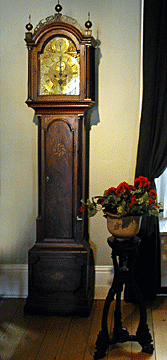 "My
grandfather’s clock was too tall for the shelf so it stood twenty
years on the floor..." So
went the lyrics of a song , written by Henry Clay Work, a songwriter not
a clockmaker, in 1876, that was to change how America looked at
tall-case clocks. The name "grandfather clock" didn’t appear
until Work wrote the song, so none of the men who actually made the
clocks ever knew them by that name. "My
grandfather’s clock was too tall for the shelf so it stood twenty
years on the floor..." So
went the lyrics of a song , written by Henry Clay Work, a songwriter not
a clockmaker, in 1876, that was to change how America looked at
tall-case clocks. The name "grandfather clock" didn’t appear
until Work wrote the song, so none of the men who actually made the
clocks ever knew them by that name.
Tall case or grandfather clocks had their start
when Christian Huygens, a Dutch scientist, applied the pendulum as the
controlling element of a timepiece in 1656, inspired by the need for an
accurate timekeeper to be used in making astronomical observations. The
application of the pendulum to clocks revolutionized clockmaking and
brought to timekeeping an accuracy that up to this time was impossible
to achieve.
However, it was the invention of the anchor
escapement by William Clement, an Englishman in 1671, using a
"seconds" pendulum, 39 inches long and vibrating through a
small arc, that cleared the way for making the weight and pendulum tall
case clock practical. This invention plus another, the dead beat
escapement, invented by George Graham in 1715, brought about the basic
clock design that few could improve on for nearly two centuries.
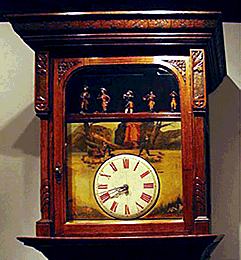 Fundamentally, these clocks consisted of four
parts: The weight, the source of power; the train, which transmitted the
downward pull of the weight into the rotary velocity; the escapement,
which transmitted the rotary velocity of the train into intermittent--or
periodic--motion; and the pendulum, the controlling element associated
with the intermittent motion of the escapement. The theory behind this
was that the force of a weight is constant, while the force of spring
may vary with its tension. Finally, a tall case provided for the full
fall of the weight. Fundamentally, these clocks consisted of four
parts: The weight, the source of power; the train, which transmitted the
downward pull of the weight into the rotary velocity; the escapement,
which transmitted the rotary velocity of the train into intermittent--or
periodic--motion; and the pendulum, the controlling element associated
with the intermittent motion of the escapement. The theory behind this
was that the force of a weight is constant, while the force of spring
may vary with its tension. Finally, a tall case provided for the full
fall of the weight.
It was decided that the beginning and end of a
week was a time not likely to be forgotten. One day was added for
safety. Thus, the 8-day clock. There was ample room in the tall case to
permit the weight of full drop for that length of time without
complicating matters with additional wheels.
The earliest clocks in America were imported by
the first settlers, who brought with them the skills of the Old World
clockmakers. Though mainly English, but also Dutch and German from the
Black Forest, and even a few Swedes, they followed the national styles
that they had learned while apprentices. Therefore, there’s nothing to
distinguish the Colonial American long-case clock from its European
cousin.
Early Clocks
 American tall case clocks were first made about 1695 in Pennsylvania and
Massachusetts and a little later in Connecticut. But there were probably
more tall case clocks made in Pennsylvania than anywhere else. From the
early days, two distinct schools of clockmaking emerged, one centered in
Philadelphia, the other in Boston. Those of the Philadelphia School
spread from New York down the Delaware Valley to Virginia and Carolina.
Makers of the Boston School were scattered all over New England. Each
developed its own recognizable style, although the first designs were
European. American tall case clocks were first made about 1695 in Pennsylvania and
Massachusetts and a little later in Connecticut. But there were probably
more tall case clocks made in Pennsylvania than anywhere else. From the
early days, two distinct schools of clockmaking emerged, one centered in
Philadelphia, the other in Boston. Those of the Philadelphia School
spread from New York down the Delaware Valley to Virginia and Carolina.
Makers of the Boston School were scattered all over New England. Each
developed its own recognizable style, although the first designs were
European.
Clock
making flourished in the Philadelphia area
from the mid-1700s to the 1840s. During this time, there were over 100
clockmakers who produced a large number of clocks, most of which are
still around and still running, said, Bruce R. Forman, an Allentown,
Pennsylvania, clock historian. "Many local clockmakers were
self-taught and had little formal education," he said. "These
were intelligent men with sound mechanical abilities."
It wasn’t easy for a clockmaker to succeed
financially in making every part of his clocks. In England, he would
have depended on brass casters, on dial-engravers, on makers of pinion
wire, and certainly on case-makers. Tall case clocks represented the
collaboration of clockmakers for the movements, cabinetmakers or joiners
for cases to house the movements, carvers to ornament the cases and
merchant importers to obtain the movements, dials, and tools Clockmakers
in the Colonies therefore tended to settle in areas with access to ports
and with other craftsmen, so that they could draw on their skills.
Many settled in urban areas and passed their
skills onto their sons. Such was the case with Jacob Hagey, who trained
his son Jacob, Jr. in the 19th century. George Hagey did the same for
his son John.
Most built grandfather clocks, a smaller
version of which became known later as a grandmother clock. Clocks often
had 24-hour faces with a sweep second hand and "monkey wheel"
escapement. On early clocks, only one of the winding holes, the one on
the right, was functional. It was used for winding the clock while the
other nonfunctional one presented a point of balance. The cost of a
typical grandfather clock in the 1780s was $7.50, and few were produced
compared to other furniture forms in the 18th century.
Until the Revolutionary War, tall case clocks
closely resembled their English cousins. But when the war ended in 1783,
casemakers began introducing their own styles which were firmly
established by the end of the century. Those made to order in the 18th
century were of superior craftsmanship and design.
Coffin Makers Made the Cases
Originally, cases for tall clocks were made by coffin makers and,
therefore, a case became known as a sarcophocus. During the mid-to late
1700s, ninety percent were made of walnut, but after 1800, most were
made of cherry and mahogany in the prevailing styles of the
period---Sheraton, Hepplewhite, Chippendale, Queen Anne and Empire.
 The
power to move the cogs and wheels of this type of clock was produced by
heavy weights that had to be wound up daily. The mechanism was encased
in a wooden cabinet with a dial that told the time. Many of the dials
illustrated the phases of the moon, the month and sometimes the day or
the week. The
power to move the cogs and wheels of this type of clock was produced by
heavy weights that had to be wound up daily. The mechanism was encased
in a wooden cabinet with a dial that told the time. Many of the dials
illustrated the phases of the moon, the month and sometimes the day or
the week.
After the Declaration of Independence in 1776,
the Colonists found themselves increasingly short of raw materials,
including copper and zinc for the brass clock movements. Makers turned
to wood for the plates and the toothed wheels of clocks, like the
clockmakers of the Black Forest of Germany in the 18th century. From
this time until about 1810, almost all American tall-case clocks were
made by hand by clockmaker-carpenters.
"The cabinets that held the works and
dials," said Forman. "Often the works, themselves, were
imported from England until the supply was cut off by the War of 1812.
The clockmakers then turned to local craftsmen to produce the needed
components. After 1812, tall-case clocks sold for between $14 and
$44."
By this time, a decline, which had begun in
1805, affected the making of tall case clocks until their eventual
demise in the 1840s after 150 years. However, some were made after that
period but were mostly mass produced and not of the same quality as the
older ones.
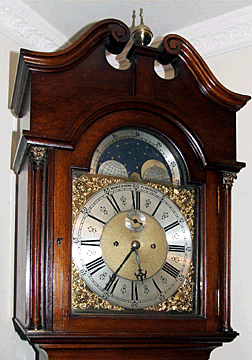 The best clocks were made in Philadelphia.
Scroll pediments atop a straight cornice and carved rosettes were
hallmarks of Philadelphia clockcases. Other features included carved
flame and urn finials, broken arch pediment with carved rosettes,
floral, leaf, and a pierced shell carving in high relief, C- and
S-scroll blind foot carving and ogee-bracket feet. However, the most
common style of American long-case clock was very similar to the English
provincial style after 1750, with swan-neck pediments on the hoods. The best clocks were made in Philadelphia.
Scroll pediments atop a straight cornice and carved rosettes were
hallmarks of Philadelphia clockcases. Other features included carved
flame and urn finials, broken arch pediment with carved rosettes,
floral, leaf, and a pierced shell carving in high relief, C- and
S-scroll blind foot carving and ogee-bracket feet. However, the most
common style of American long-case clock was very similar to the English
provincial style after 1750, with swan-neck pediments on the hoods.
A cresting on the hood locally known as
"whale’s tails" became typical of the clockmakers in
Connecticut. Makers in Boston were fond of pierced fretwork cresting
giving the illusion of a crown. The block and shell motif was popular
with Connecticut clockmakers and was usually prominent on the case door.
During the 19th century, mahogany continued to
be the wood of choice, either in solid form or as a veneer, but pine,
walnut and birch were also widely used. The more expensive cases were
frequently decorated with inlay of satinwood, cherry and maple, while
the cheaper cases were given little or no decoration and were often made
of pine or painted pine. Cases decorated with marquetry and Japanning
were rare.
Clock Dials
Before
1780, nearly all tall case clocks were fitted with break-arch
(broken-arch) dials, the majority of which were made of brass and
elaborately engraved. Since the dials were expensive to make,
clockmakers began importing handpainted metal and wood dials from
England at lower prices about 1780. The lower edge of the hood pediment
was correspondingly shaped. The shape of the top of the hood pediment
was also break-arch or scrolls, both of which were frequently decorated
with frets and finials of turned or carved wood or brass. At each front
corner of the hood was a wood column which might have been plain,
baluster, Jacobean or Corinthian. The Corinthian ones were sometimes
fitted with brass capitals. Identical columns were frequently fitted at
the rear corners of the hood and matching quarter columns on the front
corners of the trunk and the plinth.
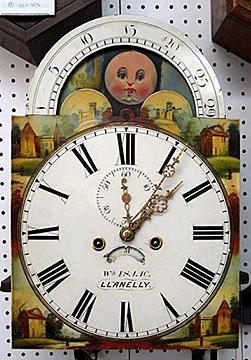 To gain access to the movement the hood had to
be removed by sliding it forward off the trunk. A door in the trunk
provided access to the pendulum and weights and lines. Clocks fitted
with wooden pull-up movements were wound through the door opening. To gain access to the movement the hood had to
be removed by sliding it forward off the trunk. A door in the trunk
provided access to the pendulum and weights and lines. Clocks fitted
with wooden pull-up movements were wound through the door opening.
Clock faces made of enameled or painted iron
were on the market and in use at the time. Thomas, however, seems to
have used only brass dials. The works, as well, were all made of brass
and were imported from England.
Enameled dials were imported in large
quantities at the end of the American Revolution. Up to this time the
chapter ring, the circular band on a dial in which the numerals or
chapters, in black against a background of white, were engraved or
painted, contained only Roman numerals, but with importation came the
introduction of Arabic numerals.
Spandrels, the space between the curve of a
chapter ring and the corner of a square dial plate. were decorated with
figures, flowers, birds, fruit, scrolls and geometric or foliage
designs, while the lunette(area occupied by the dome-shaped top of the
break-arch dial) often contained pastoral scenes, landscapes, seascapes,
buildings and animals in a variety of colors.
A further embellishment was the use of automata
in the lunette. Typical examples were a lady on a swing, a fisherman
casting his line, a rocking ship and a blacksmith at this anvil, all of
which were made to move by the action of the pendulum.
Paper dials came into use about 1792. They were
glued onto metal and wood plates and fitted to the cheapest clocks.
Brass dials went out of fashion in favor of painted ones by the end of
the 18th century when the use of Arabic numerals became widespread.
Painted clock dials, in common use after the Revolution, were usually
bought from dealers and weren’t made by the clockmakers themselves. A
local artist was then engaged to add decorations. Tulips and other
flowers were popular, as were birds, especially the turtle dove, a
symbol of love and beauty. Stars were also used. Although 19th century
dials continued to be break-arch in shape, the square portion increased
in size to 10 ½ inches to 14 ½ inches.
Sunrise to Moonrise
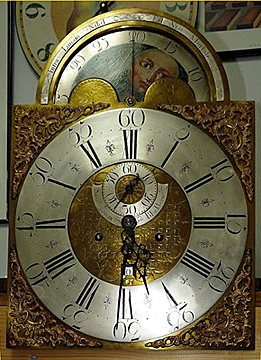 Many clocks began to display the phases of the moon through an
aperture cut in the lunette. This arrangement consisted of a disk, with
teeth cut in the rim that rotated behind the dial once in every two
lunar months. Two full moons positioned diametrically opposite were
painted on the disk. On the arch at the top of the main dial is a scale
graduated in 29 ½ equal divisions. The bottom edge of the lunette
aperture is shaped with two semi-circles, one at each side, which were
sometimes painted to represent the east and west hemispheres of the
globe. Many clocks began to display the phases of the moon through an
aperture cut in the lunette. This arrangement consisted of a disk, with
teeth cut in the rim that rotated behind the dial once in every two
lunar months. Two full moons positioned diametrically opposite were
painted on the disk. On the arch at the top of the main dial is a scale
graduated in 29 ½ equal divisions. The bottom edge of the lunette
aperture is shaped with two semi-circles, one at each side, which were
sometimes painted to represent the east and west hemispheres of the
globe.
When the disk rotated and the painted moon
appeared from behind one of the semi-circles, it presented the
appearance of a new moon which, as the days move on, gradually came
further into view until it was completely visible, at which stage it
represented a full moon. As the disk continued to rotate, the moon
slowly disappeared behind the other semi-circle until it was out of
sight, by which time the other painted moon was ready to appear on the
opposite side to begin a new lunar month. Positioned at the top of each
moon was a small pointer adjacent to the graduated scale from which the
age of the moon could be read.
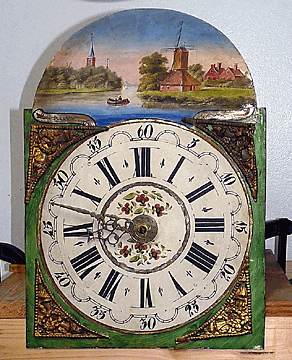 Colonial clockmakers were conspicuously
date-minded. With few exceptions, clocks had one of two mechanisms to
register the days of the month. One consisted of a hand and dial,
counterbalancing with the shape of the hand measuring seconds. The other
consisted of a small square or notch. Both of these date mechanisms had
to be reset at the beginning of each month. Colonial clockmakers were conspicuously
date-minded. With few exceptions, clocks had one of two mechanisms to
register the days of the month. One consisted of a hand and dial,
counterbalancing with the shape of the hand measuring seconds. The other
consisted of a small square or notch. Both of these date mechanisms had
to be reset at the beginning of each month.
Most dials were painted with a small subsidiary
dial for displaying seconds. Sweep-second hands weren’t common. Dial
hands were individually cut by hand until about 1825. Craftsmen, who had
set themselves up as clock had makers, carried out the delicate work of
piercing and filing to shape. Since this was an expensive operation,
clockmakers turned to the less costly and more productive method of
stamping hands from thin sheet metal.
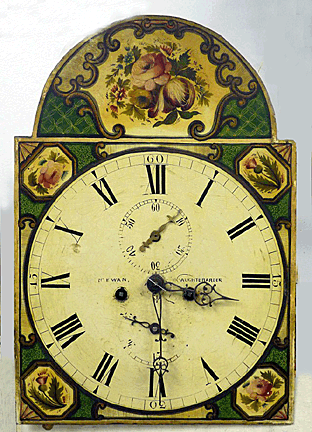 The number of key holes in a dial indicated the
clock’s type of movement. One winding hole indicated that there was
only a time train to wind. Such a movement was, strictly speaking,
merely a timekeeper, not a clock. Two winding holes were for the time
train and a strike train, and if three winding holes were present, the
third or center hole was for winding a chime or musical arrangement.
When there were no
holes at all, winding was achieved by pulling on the weight line through
the trunk door opening. The number of key holes in a dial indicated the
clock’s type of movement. One winding hole indicated that there was
only a time train to wind. Such a movement was, strictly speaking,
merely a timekeeper, not a clock. Two winding holes were for the time
train and a strike train, and if three winding holes were present, the
third or center hole was for winding a chime or musical arrangement.
When there were no
holes at all, winding was achieved by pulling on the weight line through
the trunk door opening.
Identifying Tallcase Clocks
In addition to gluing a printed label to the inside of the trunk,
clockmakers usually had their name and town and sometimes the year of
manufacture, painted on the dial. Clock papers, the starting point for
identifying and aging a clock, were printed in about 1800. These gave
the name and town of the maker, and instructions for winding and setting
up, maintenance and sometimes announced details of after-sale service.
The movements of tall case clocks were either
30-hour or 8-day, depending on whether they were made of wood or brass.
Wooden movements had oak plates and either leaf or lantern pinions. Only
the escape wheels were of brass. Up until 1810, the most common type of
movement was the 8-day brass with two weights. The 30-hour brass
movement had an endless rope and one driving weight, while the 30-hour
wood movement had two weights and a dial wind or pull up wind. The era
of brass movements in tall case clocks was all but over by 1825.
Tall-case clockmakers didn’t inscribe their
names at any particular place on their clocks. Some put it on the boss,
some in the middle of the face, and some at the bottom of the face
between and below the Roman numerals V and VII. As the clockmaker Isaac
Jackson etched on to the face of one of his clocks: "Time Passeth
Swiftly Away."
What to Look For
Three items affect the value of a clock: age, the intrinsic merit of
the clock and case, and the name of the maker. Only the very oldest
clocks are valuable for age alone. If a clock has great age, a movement
of superior technical design and workmanship, a case of fine wood and
workmanship and architectural beauty, then it has great value.
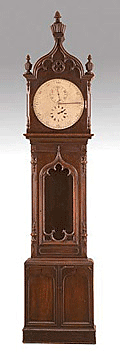 Between 1682 and 1750, clocks were found only
in the homes of wealthier colonists, who called them "tall"
clocks. Most were imported from England and the clockmakers were largely
confined to Philadelphia and the adjacent counties of Chester and Bucks
in Pennsylvania. Between 1682 and 1750, clocks were found only
in the homes of wealthier colonists, who called them "tall"
clocks. Most were imported from England and the clockmakers were largely
confined to Philadelphia and the adjacent counties of Chester and Bucks
in Pennsylvania.
By 1750, the increasing wealth of the colonists
brought about a demand for more clocks. Those who served
apprenticeships, as well as European clockmakers who emigrated to
Pennsylvania, now set up west of Philadelphia. For the next 25 years a
clockmaking boom hit the region, only to be halted abruptly by the
Revolutionary War. Even though there were a good number of clockmakers,
clocks were still only for the relatively wealthy.
The handmade tall case clock enjoyed a revival
in 1800, as prosperity returned. There were few communities that didn’t
have at least one and sometimes two or three clockmakers. Even farmers
had clocks. The revival continued until about 1830, when the New England
shelf clock, costing only a fifth as much as a handmade tall case clock,
appeared in Pennsylvania. In the absence of records, it’s most likely
that any tall case clock made in Pennsylvania would most likely have
been made from 1800 to 1830.
Tall case clocks carried a great sentimental
value for their original family owners. This is why many were originally
sold at sales, rather than at public auction.
The Tallcase Market
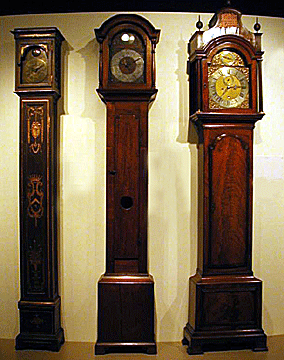 "Tall case clocks have three distinct markets:" said
Phillip Bradley, Jr., an antique dealer who specializes in tall case
clocks at Phillip Bradley Antiques in Downingtown, Pennsylvania.
"Clock collectors, who are interested in tall case clocks as time
pieces like the members of the National Clock and Watch Association; the
serious collector, who’s interested in them as antique objects,
themselves; and the general public, who appreciates them because they
link the present to the past and have a distinctive presence in a house.
They ring and tick. They’re big. They stand out. They ask to be
noticed." "Tall case clocks have three distinct markets:" said
Phillip Bradley, Jr., an antique dealer who specializes in tall case
clocks at Phillip Bradley Antiques in Downingtown, Pennsylvania.
"Clock collectors, who are interested in tall case clocks as time
pieces like the members of the National Clock and Watch Association; the
serious collector, who’s interested in them as antique objects,
themselves; and the general public, who appreciates them because they
link the present to the past and have a distinctive presence in a house.
They ring and tick. They’re big. They stand out. They ask to be
noticed."
He noted that tall-case clocks are working
objects that serve a purpose. Restoration people look to these clocks to
establish dates, since many of them were signed. Those that Bradley
sells range in date from 1760 to 1810 and, currently, are mostly local
Mid-Atlantic examples.
 Pricing for tall-case clocks varies between
30-hour and 8-day varieties. "A rare 30-hour clock can be
expensive," added Bradley. "The rarity and desirability of the
maker and the stylistic consideration of the case and works are most
important. The amount of gadgets in the works like moon dials are less
important." Pricing for tall-case clocks varies between
30-hour and 8-day varieties. "A rare 30-hour clock can be
expensive," added Bradley. "The rarity and desirability of the
maker and the stylistic consideration of the case and works are most
important. The amount of gadgets in the works like moon dials are less
important."
According to Bradley, the main difference
between an antique collector and a clock collector is the degree of
elaboration and success of design of the case. "A clock collector
is more into the mechanics of the clock. The antique collector, on the
other hand, looks at tall-case clocks as complicated objects, for which
the person who made the works and case are usually different. The third
part of the equation of value is the originality of the whole design. To
me, the working condition is the least important. I can always send a
clock out to be repaired. I’m selling an artifact from a previous
era."
Antique collectors seem to be most interested
in not only who made the clocks but also where they were made. "An
old clock cannot be divorced from its maker, for no clock can be better
than the skill and patience of the man who made it," Bradley said.
An average Pennsylvania clockmaker might construct only four or five
clocks a year.
Famous Makers
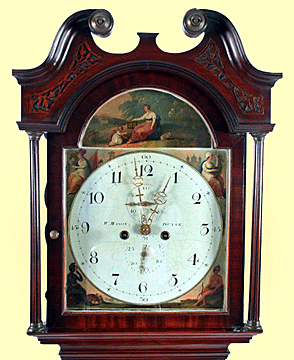 The most famous clockmaker of the colonial era was David Rittenhouse
of Philadelphia. He established himself as a clockmaker in 1749 a the
age of 17. Later he specialized in astronomical clocks, some of which
showed the motions of the planets. Other clockmakers included Edward
Duffield and John Wood, Jr. All had a distinctly American flare The most famous clockmaker of the colonial era was David Rittenhouse
of Philadelphia. He established himself as a clockmaker in 1749 a the
age of 17. Later he specialized in astronomical clocks, some of which
showed the motions of the planets. Other clockmakers included Edward
Duffield and John Wood, Jr. All had a distinctly American flare
Usually the original owner of a clock and the
clockmaker knew each other personally and lived together in the same
community. The clock, more than anything else, was a symbol of family
stability in Pennsylvania. Sometimes, when faced with selling off the
family possessions, a family kept its clock. They were often mentioned
in wills as possessions of importance to be handed down from generation
to generation.
The entire life of a colonial farm was
regulated by the timepiece in the kitchen. The care and winding of the
clock, since most were of the 24-hour variety, became almost a ritual.
If a clock had a secret device for controlling the face door, it most
likely came from a rural home. In these, the only way to open the face
door was usually by reaching up through the panel door and releasing a
catch. The panel door, in turn, was fitted with a lock and key. However,
to open the face glass and regulate the hands, it was usually necessary
to know the secret method for opening the door. City clocks, usually
regulated by a servant, didn’t have this feature.
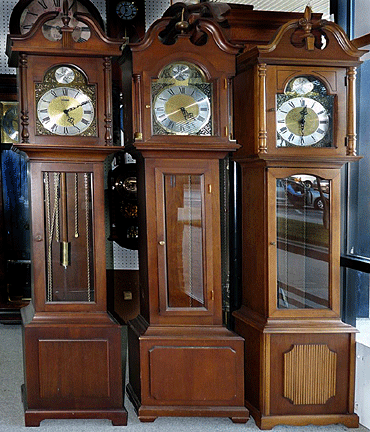 Early clocks like those made by Abel Gottey,
who emigrated with William Penn and set up shop in Philadelphia in 1682,
were plain, with flat-topped hoods. Even though decorations were added
to the hoods and faces, the cases continued without decoration. The
curly horns of the English provincial style appeared on the hoods of
American clocks and remained until the turn of the century, when a
simple band inlay was added to the cases. Free standing corner pillars
on the hood were fashionable from 1760 to 1820. Early clocks like those made by Abel Gottey,
who emigrated with William Penn and set up shop in Philadelphia in 1682,
were plain, with flat-topped hoods. Even though decorations were added
to the hoods and faces, the cases continued without decoration. The
curly horns of the English provincial style appeared on the hoods of
American clocks and remained until the turn of the century, when a
simple band inlay was added to the cases. Free standing corner pillars
on the hood were fashionable from 1760 to 1820.
Break-arch top hoods began to appear in 1790.
They had their outer edge decorated by a crest or band of irregular
outline, commonly known as "whales tails." Later this cresting
became a little wider and pierced and produced a very tasteful effect.
After more than two and a half centuries, the
weight-and-pendulum clock in a tall case is still the best designed
mechanical device for accurate timekeeping. Some of the best collections
of original colonial tall-case clocks can be seen at the University
Museum of Clocks and Watches in New York City, at the American Clock and
Watch Museum, Bristol, Connecticut, and at the Chester County Historical
Society, West Chester, PA.
To read
more of my articles, please
visit
my Web site.
<
Back to Antiques Articles
Next Article
> |
